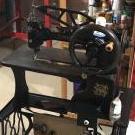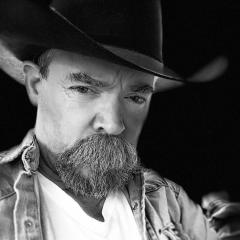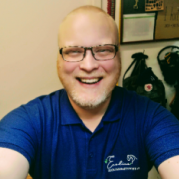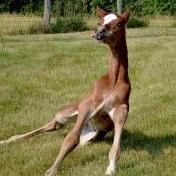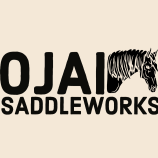-
Content Count
4,065 -
Joined
-
Last visited
About bruce johnson
-
Rank
Saddlery & Tack Moderator
- Birthday 06/15/1960
Contact Methods
-
Website URL
http://www.brucejohnsonleather.com
-
ICQ
0
Profile Information
-
Gender
Male
-
Location
Oakdale, CA
-
Interests
leather tools and history
LW Info
-
Leatherwork Specialty
Leather Tools
-
Interested in learning about
everything
-
How did you find leatherworker.net?
Ive been here from about day one
Recent Profile Visitors
48,423 profile views
-
Exactly right! When they grab and throw a tool it is exciting. I reverse the buffers on the cradles so they rotate away from me on the top. I work off the top of the wheel where I have better visibility of the edge and maintain a more consistent angle. I have arrow stickers on the top of every buffer showing the direction of rotation to keep it in mind. When I had a helper the arrows reminded him these are opposite of most shops. I don't throw tools like I used to for sure. when I do it is thrown away from me and not into my lower body like it was before I reversed them all. The wheels I had the most problems with grabbing a tool are the airway pleated wheels. The chrome detailers, refurbishers, abrasive dealers all told me how great they are - longer life, hold compound better, run cooler, etc. Buy them, guarantee you will like them they said. I bought a decent assortment of airways and I was throwing tools like a monkey throws poop. Those pleats were like hands grabbing the back edge of a knife or even a shank on a handled tool like a creaser. My shop helper found jobs in the other shop areas. I figured I was in the learning curve and mucked ahead. After a week I was not much better - gave up and took them all off.
-
I've done a bunch with hair-on. I have used them for bags and pillows some. You just have to know you can walk on these for years and no hair slips. Put it on the back of a bag and a ladies purse will be bare in the 3-4 months from rubbing against them. I don't know why that difference!. I mostly used them for inlays on rope cans and bags, notebooks, restaurant menus and wine lists, and bigger things. I did a few hundred contract belts with hide inlays too. I like working with hair-on a lot but It can be messy. Pattern cut from the flesh side. Pay attention to the lay of the hair and how it will be oriented on your work.
-
Seems like a good time to bring out the OSHA-like safety poster I made up several years ago for the door to my tool working shop. It is laminated and still there for a daily reminder.
-
The Rocky Mountain Leather Trade Show is coming right up on May 17-19. Classes start earlier in the week and continue through the show. This is the biggest leather trade show and continues to grow. Last year there was a last minute change of venue and some learning curve there but the Leather Crafters Journal has smoothed out the bumps and this year's class selection and vender layout looks to be great! Classes, informal BSing and socializing with a world wide attendance, the Leather Debut Show of judged entries will knock your socks off, and lots of venders. I am starting to pack tools today and we have the same location as last year - first hallway near the entrance. Lots of people in this group use a screen name but if you are there, please stop by and introduce yourself! Free stickers and the famous 6 inch Bruce Johnson Leather Tools rulers are free as well, plus a regionally famous candy dish. Oh yeah, we will also have a good selection of refurbished and new leather tools. Here is a link to the exhibitor list and map - https://leathercraftersjournal.com/rocky-mountain-leather-trade-show/exhibitors/ Hope to see you there! - Bruce and Rundi
-
I guess for the few minutes it takes, I usually just sit there and watch it simmer. Never let it boil away before. Evaporust is safe for wood and rubber so cold soaks are fine.
-
Just a tip with the Evaporust. If you want to save time you can heat it a bit and and reduce a 24 hour soak into about 10 minutes. It is a temperature dependent process. I got this tip from a phone call to the shop of one of their endorsers several years ago. The temperature is "cool enough you can stick your finger in but too hot to leave it there". Kind of a wisp of steam coming off but no bubbles. I put the parts in an aluminum pan with enough Evaporust to cover and turn the burner on. After the parts are clean, filter the Evaporust back into the jug and rinse the parts with water. Then I use a brass wheel for stamps or steel wheel for other parts to knock off the carbon and residue left behind and start the polishing process.
-
It depends on what the tools are. Realistically unless they are museum or display pieces that need to look the part, removing the old paint and repainting has little to do with lessening value of leather tools. Other tools yes, but most leather tools are going back to work, not be on display or to traded between collectors. It blows away some of my general tool collectors friends what I do that they could never think about with refurbishing. They would kill the value and I don't. I've pretty well tried it most processes and it's evolved - scotch brite, strippers of all varieties, abrasive wheels and papers, etc. Some of these old paints are hard a rock and just laugh at strippers and solvents while others dissolve like KoolAid. I never knew what was going to happen from piece to piece. Here is my process now. I have blast cabinet and blast them down to bare metal. That has been the great equalizer. Faster, gets into the pits, takes off rust as well as paint, and leaves a clean surface with minimal residue I can blow off and go straight to paint. No rinsing off a stripper or residue that resists paint. In the old days a local powder coating outfit blasted for me at an hourly rate. Once I set enough money away I bought a big compressor and blast cabinet. After blasting I smooth and polish every place that needs polished with several abrasives and compounds to the desired finish and then tape off the areas that don't need paint. A coat of primer and let it dry a day. Light coats of rattle can paint for color. I use ACE brand matte or gloss and Rustoleum hammer finishes mostly. I use light coats from a distance every 10-20 minutes until I get the coverage I want. Usually 2-3/maybe 4 coats. In the winter I've got a heated drying cabinet I hang them in. I let the paint cure for at 24 hours or more before handling. Punches and things like that - I blast, polish, and sharpen. I stopped repainting punches a few years ago. I was offering it for $5 more and essentially nobody wanted it. I like powder coated finishes but that's an involved process with more equipment and time that just doesn't pencil out for me right now.
-

Burnisher machine recommendations please
bruce johnson replied to Stratton's topic in Leather Machinery
Another vote for the Cobra if you can swing it. I used a drill press and wooden burnishers for years. Burned up two drill presses and went through several burnishers. I got my money's worth out of them for sure with the amount of production pushed through them. Last year my wife bought a Cobra burnisher at Prescott. My nephew used to come down when he had enough work stacked up and use the Ferdco to sew on and then burnish on her Cobra. This year he had us haul home a Class 4 Cobra machine and burnisher from Prescott for him. My wife and nephew don't seem to be violent people but I expect somebody would be bleeding if they tried to take away those burnishers from either one. I had a Weaver through here a few years ago. As much as I like those folks from Mt Hope, that burnisher was not my favorite. It takes up bench space and not the handiest to get around. Fixed speed of 1725 RPM The Cobra is on a pedestal stand and variable speed (2000-3450 RPM). Smaller footprint and about $400 less expensive. -
I've been using tubes for about 20 years and know of people doing it longer. The tubes fit well into a Gorilla Rack system. When we were renting the place this wasn't insulated and during the winter it might be 40 degrees and 90% humidity in there and summers might be 100 degrees and 15% humidity. Not problem number one with the leather ever. Excuse the background of the pictures. These are from about 16 years ago right after we bought the place and were converting the garage to the leather shop. At one time I had three of these racks of leather mostly all in tubes. The skirting wasn't in tubes because I was going through 2-3 sides every week or two. Other vegtan was sorted by thickness. The chrome tans were sorted by color to prevent any contact color bleeding.
-
Seeing that brings back memory. I drilled the head off and slid the tip off. It was a soft nail that peened the tip on the inside of the top. Years ago .... I vaguely remember saying a lot of bad words and spending way too much time for what I quoted.
-
I used to get some three piece sets with a slotted headless screw to secure the tip. Jewelers screwdriver if that that is the case. If there’s no slot then drill it as dikman said. They usually are too small for an easy out.
-

6 inch hollow ground Splitter blades need sharpening
bruce johnson replied to Doc Reaper's topic in Sharpen it!
The only commercial shop I would trust for a splitter blade is ....none of them unless you really know their work. They mostly all say they can, but I get the results to fix. Coarse grit patterns, irregular bevels, or wavy edges. I would only trust a shop that does planer blades and can go out to some ridiculously fine grits. I cant speak to Weaver or my pals at Cobra. By hand take your pick - wet-dry or stone, then strop. The mechanics aren't hard, maintaining a consistent angle the entire blade width by hand is. I have been sharpening splitter blades at least 25 years/selling tools as a business for 14 years and I'd like to have every edge tool I did in the first 23 years back. What has changed is that I have evolved with machines, abrasives, jigs, fixtures, and a sharpness testing system that have helped me improve significantly. Currently I say don't do outside sharpening but always resharpen anything bought from me (new or used) for no cost - just the cost of return shipping. That said, I have weak moments and do some outside work. If you get in a jam, call me. I am seriously busy with prepping for the Sheridan show right now and once I'm past that - I'm a lot more open.- 11 replies
-
- splitter blades
- 6 inch splitter
- (and 3 more)
-
Randy, David Mabe has been working on some old vintage stamp replicas and he has the Prairie Rose dialed in. I have seen his progression and the ones he had for sale at Prescott are a dead- on match to the original Hamley prairie rose stamp that McMillen made. I bought one from him just so my saddle size McMillen can stay here and not continue to get frequent flier miles out on loan for folks rebuilding or recreating the Hamley saddles. David should have a good stock of them at Sheridan, as well as some old FK Russell and other McMillen stamp designs he'd been working on.
-

Price Comparison: Fiebing's Neatsfoot Oil
bruce johnson replied to BigDogPaul1962's topic in Suppliers
Oils start a good healthy discussion whenever they pop up. At one time neatsfoot was only from lower legs of cattle. Due war-time shortages the specs were relaxed and animal fats were allowed. Cold pressed hog lard oil seems To be the common lore. So this pure NF oil may not be what is is 100 years ago. Compound is a blend - might be vegetable or mineral oil blended with some level of animal origin oil. The major players have a fixed formula and should be more reliable batch to batch than grabbing a generic compound from a seller one time and another seller next time. Several makers use compound, pure only, olive oil, generic vegetable oils, etc. you seem to find the combination of whatever oil with whatever tannage you are using and stick with it. -
It’s a gray zone. Burnishing implies some level of heat and bonding of the leather fibers to make it slick. Heat can be from friction or an outside source like an edge iron. Slicking is smoothing. You can literally do that with anything - water, saddle soap, etc and smooth the edge. It likely won’t stay as smooth as a burnished edge over time. Different types of leather behave differently with edge treating.


.thumb.jpg.6d6fd2a73114af60b208059411973bac.jpg)
